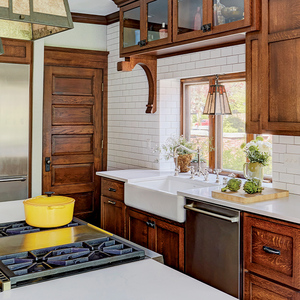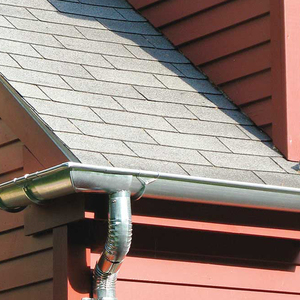I have been fiddling with finishing a cherry door endlessly of late trying to get that beautiful cherry look, but without all the blotching. I have followed the finish method suggested by Jeff Jewitt in FWW, but am not totally pleased with my result. I was planning to finish all of my trim using this same method, but that will be far to tedious for the result I am seeing. How do others finish cherry trim when they have fussy owners that want that nice cherry look without waiting for the cherry to do it naturally?
Discussion Forum
Discussion Forum
Up Next
Video Shorts
Featured Story

Listeners write in about shower panels and cordless tools and ask questions about old wiring, air leaks, and gutter covers.
Highlights
"I have learned so much thanks to the searchable articles on the FHB website. I can confidently say that I expect to be a life-long subscriber." - M.K.
Fine Homebuilding Magazine
- Home Group
- Antique Trader
- Arts & Crafts Homes
- Bank Note Reporter
- Cabin Life
- Cuisine at Home
- Fine Gardening
- Fine Woodworking
- Green Building Advisor
- Garden Gate
- Horticulture
- Keep Craft Alive
- Log Home Living
- Military Trader/Vehicles
- Numismatic News
- Numismaster
- Old Cars Weekly
- Old House Journal
- Period Homes
- Popular Woodworking
- Script
- ShopNotes
- Sports Collectors Digest
- Threads
- Timber Home Living
- Traditional Building
- Woodsmith
- World Coin News
- Writer's Digest


















Replies
I love cherry.
I like to wipe on a coat of Waterlox tung oil finish to give it some color, then I usually use a water-base finish on top for protection.
About the only way to give it that "aged " look is to use a gel stain. That will minimize the splotching. Then finish as desired.
But it won't look as good as letting the cherry age naturally.
> But it won't look as good as letting the cherry age naturally.Not only that, but after the cherry does age naturally, it's going to be very dark and probably sort of muddy in appearance.George Patterson
thats good to know for the future doors.
What sort of gel stain have you used, Shep? I have never colored cherry except for linseed oil, and would like to try it sometime.
Dustin
Like Sphere, I've had good luck with Clearwater Smooth & Simple gel stains.
I like applying the stain with a Scotch-Brite pad; for some reason, I seem to get better results than over a rag.
Just remember to wear some kind of rubber gloves, unless you like strange skin colors.
Well, Thank YOU!
IIRC, the CWCC gel is called Antique Cherry, I have some around here some where.
I also have all the base concentrates that pigment the stains...VDbrown, Burnt+ raw Sienna, Burnt and raw Umber, and Phlalo Green and Blue...some orange and yellow and carbon black, and titanium white, fills out my milk crates.
One problem that I THINK still haunts most WB stains, is the chance that , red oak, will get a greenish -hue, at least it did back then...Golden oak is a fine line in WB finishes, as is Cherry ( antique'd).
As much as I have invested in WB learning curve, it all boils down to taste and eyesight. Antique Cherry stain, still looks like stain to me.
Now if you want to color a pore filler , for species like mahog, add a bunch of tint base to the filler ( i use a secret blend, LOL) and have at it...the stain is applied after the wash coat that seals the spackle, I mean pore filler..(G).
There are many top coats that contain UV blockers now..that right there is a recipe for diaster, not to mention compatability issues.
Michael almost fired me, one day..I added an 8oz cup of fast lacquer thinner to a gallon of WB Hydro-cote Polyshield, and refinished our shop doors, I violated the curtain of VOC's, but MAN, what a cool finish I got..
Take a chance. Experiment, and learn.Parolee # 40835
Cherry darkens really fast...try again to talk your clients into a natural finish...nothing else will let you see the wood grain so well, and the blotchyness goes away eventually.
Amber Shellac???
I don't Know what I am doing
But
I am VERY good at it!!
This too blotchy?
http://forums.taunton.com/tp-breaktime/messages?msg=71033.8
Two coats of Watco fruitwood. Following by two coats of amber shellac. (scraped betwixt coats with a utility knife blade. I'm believing that makes a difference in blotchyness.) Then 4 to 6 thin coats of waterborne Ultima Spray Lacquer. Again scraping between coats.
Well, most of what you got as far as info is good so far.
Here is my 2 cents,of how I do it ( well, a few ways of how have done it) .
I would start with a minwax red mahogony stain/ and few dollops of dark walnut and then seal it with a coat of "seal -cote" shellac..then any finish ya want can be top coated on.
Bear in mind PLEASE, that an UV inhibitor type top cote, such as Hydrocote WB Polyshield, will not allow further darkening!!! This is important to know, that is why you stain to color desired first.
Next is a gel stain AFTER a wash coat of sealcote...works well.
Third, leave everything out in the sun for a spell, and wipe/spray whatever ya want.
If the blotch is so bad you have to hide it, a wash coat is the only thing that keep the STAIN from doing that, want no blotches? Don't stain raw wood.
There's your 2cents worth....
Parolee # 40835
You've probably done more finishing than I.
I like making furniture- I hate finishing. Reminds me of painting.
That's why I use Waterlox on a lot of the stuff I make. Or I spray finish. Or a combination of the two.
I rarely stain anything I make, unless it's a repair. And matching new wood to old is a skill I'm still learning.
I can understand why the old-time furniture makers subbed out the finishing to experts.
I used a watered down analine stain first, 1lb cut dewaxed shellac washcoat, but because I could not find a gel stain in our hardware stores that i liked, I ended up using a cabaret stain. Bad idea. Bartley does have a gel stain i like, but yet another thing I will have to order.
I did not know that the poly would stop the aging process. I read in a finishing book that regardless of the final finish, cherry will continue to darken and thought that applied to poly also. Kind of makes sense.
Thanks for your two bits.
I've had the pleasure of working side by side with Michael Dresdner, we developed the line of Hydro-cote and ClearWater Color Company finishes.
You can order any of the gels ( I think) from Highland Woodworking, in Atlanta.
More later..I gotta zip to work.Parolee # 40835
Thanks to all, very helpful tips to try for the next doors. More ordering. A friend took a look and told me I was being way to critical and the final product looked great. The one area not taking stain looks like a glue squeeze out problem combined with a poor clean-up. Definetly a problem i can correct. I think I am my worst enemy.
Brad,
Here's two cents more, soon you'll be up to a nickel ;0).
I am currently finishing some cherry cabs and a bar. I was also concerned about the blotchy effect as well as not getting it too dark, but still wanting that warm cherry color.
I used 50/50 mix of dewaxed shellac and denatured alcohol as a base coat, followed by a second coat of dewaxed shellac and then two coats of water based poly.
If you intend to use poly, either waterbased or reg., do not use regular shellac. It contains wax and can cause problems with the adhesion of the poly.
I experimented with some tinting of the base coats for some of the lighter/blonder cherry and the whole thing has a really warm color now. Still in the process of completing the project so I may tweak it a little more as I go.
I posted a question about this over at knots and got some really good advice from the guys over there. You could do a search under my name at Knots and read what they posted, but there is also a ton of other good info there on finishing.
Best of luck
I am also following suggestions from Knots. Do you think the tinting is repeatable? I tried samples too, but they were too small and really did not give a good indication of what the final product would look like.
Brad,
I sacrificed more than my share of cherry plywood "scraps" to experiment with the colors. I think that is what made me so nervous about having a really sterile looking product, the scrap doesn't always reflect your whole project.
What I ended up using is 1-2 drops of Transtint in 8 oz of my shellac. I tried 2-3 different colors (not cheap btw at $17 a bottle) finally settled on the reddish brown. One of the nice things about that product is that you can add it to any finish. From what I understand, it is better to add it incrementally to any of the steps so you can continue to warm it up as you go.
As I have continued with this process, I have been pleased with the results, but I think the wood has started to darken on its own. Mind you, this is in a basement and the bar and cabs do not see direct natural light.
In hindsight, I think that 2 coats of Zinnzer Seal Coat and 2 coats of WB poly would give me what I wanted without the variable of the tint.
This finish ended up being more steps than I would have liked (with about a 4-5 coat process) and I continue to learn as I go, but again, I am very happy with the results.
I'm far from a finishing expert, but we've had good luck with Zar cherry stain on cherry, with lacquer over it.
We were always die-hards about only using clear finishes over cherry, but on a kitchen I did last year, the HO's wanted a little different color, & that's what my finisher came up with.
Liked it so much, I used it on some of the cabinetry in my own house. It does seem to look better on our local cherry (Minnesota) than from elsewhere. (PA & such).
If you have access to Zar, get a pint & try it. Not usually a fan of Zar stains, but in this case, its pretty good.
Mike
I haven't tried staining cherry, but had pretty severe blotching recently with waterlox tung oil. Fortunately I experimented with some scraps first. In an effort to minimize the blotching, I first saturated the wood with mineral spirits to engorge the soft spots (these areas of soft wood are what show up as darker blotches under stain or penetrating oils). Once the wood wouldn't take anymore mineral spirits I rubbed in some wiping poly, thinned about 50/50 with min. spirits. This was the "seal coat". After everything dried, I wiped on a couple more coats of thinned down poly, rubbing in between coats with 0000 steel wool. The final look and feel was smooth and silky, much like an oil finish, not blotchy, and not shiny like a film of poly.
Try minwax poly-oil.
It's easy to apply, easy to re-apply/touch-up, hard to mess up, pretty durable. I'm doing all the walnut trim in my house with that finish. I do like a full poly film finish (this is not a film finish), but it will be much harder to apply and maintain over time; the oil finish will be able to be maintained over time.